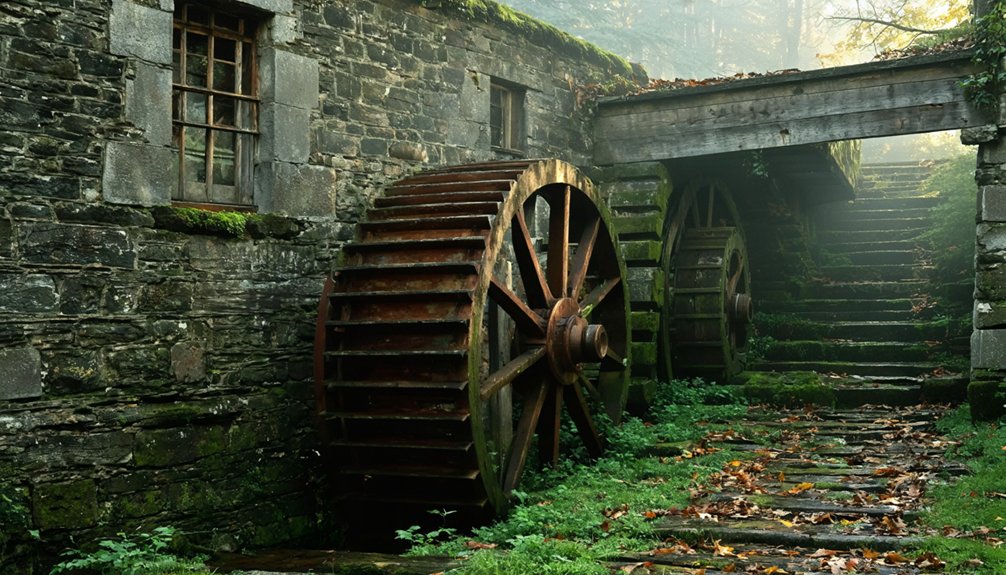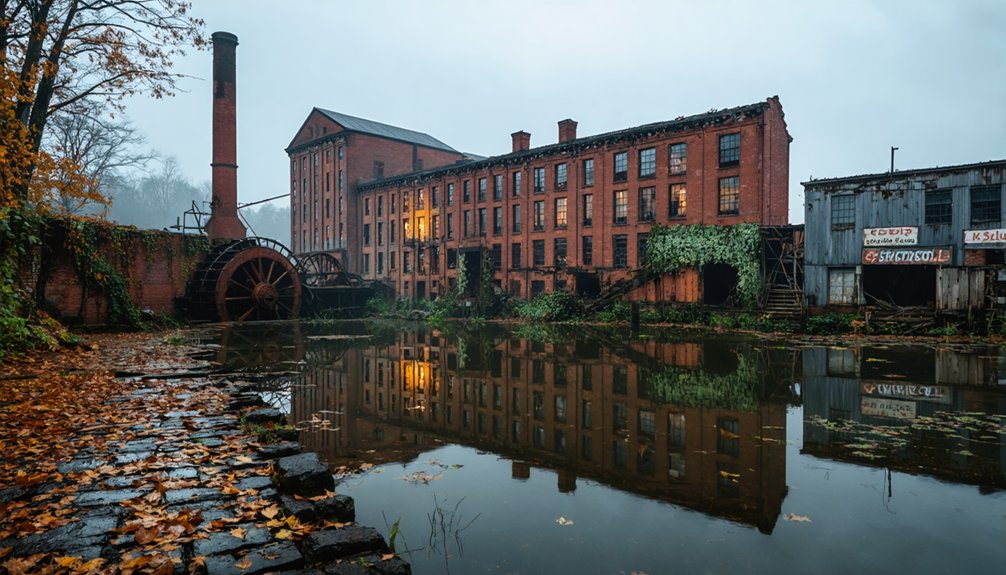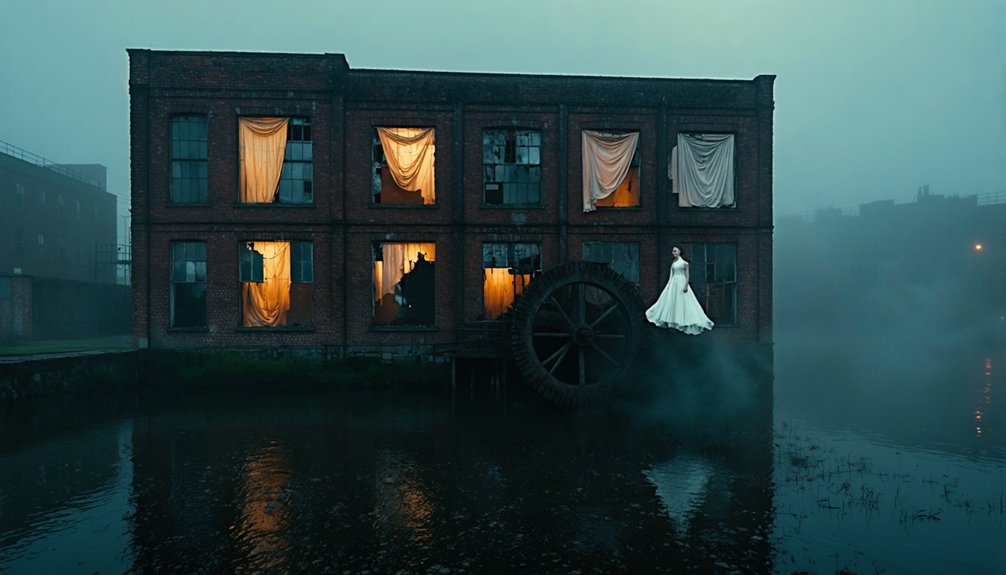To capture the haunting beauty of old mill ghost towns, you’ll need a weather-sealed camera, varied lenses, and reliable illumination. Visit during golden hour when soft light enhances weathered textures and architectural details, or embrace morning mist in autumn for ethereal atmospheres. Focus on multi-pane windows, exposed beams, and abandoned personal items that tell human stories. Winter’s low sun creates dramatic shadows while revealing the industrial skeleton. These forgotten landscapes await your patient eye to resurrect their tales.
Key Takeaways
- Photograph during golden hour or morning mist to capture ethereal light that enhances the atmospheric quality of abandoned mill structures.
- Use wide-angle lenses for architectural context and telephotos for compressing elements against atmospheric backgrounds like fog.
- Focus on human remnants such as personal belongings or handwritten notes to create emotional connections to former inhabitants.
- Incorporate textural elements through post-processing techniques to evoke nostalgia and historical authenticity in your images.
- Explore various seasons for distinct photographic opportunities – autumn for color contrast, winter for dramatic shadows and frost details.
The Rise and Fall of America’s Historic Mill Towns
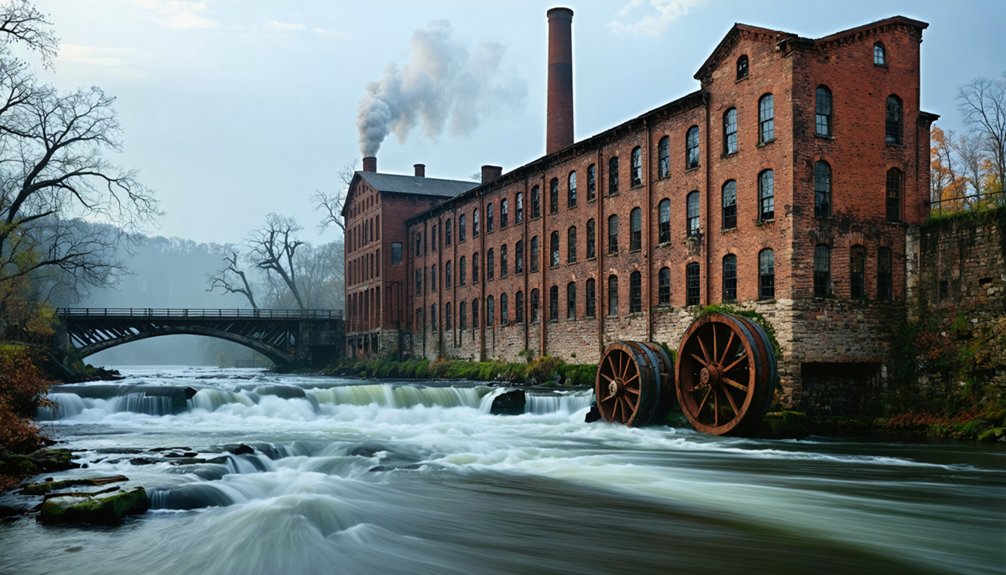
Dozens of America’s historic mill towns began as simple frontier outposts before evolving into thriving industrial centers that fundamentally shaped the nation’s economic landscape.
You can trace this remarkable community evolution from early settlements like Millville, Iowa (1833) and Bowenville, Georgia (1847) to industrial powerhouses like Port Gamble, Washington—established in 1853 as the Northwest’s first purpose-built timber town.
The story of Motor Mill in Clayton County exemplifies this pattern, with its sawmill operations beginning in the 1850s and culminating in the construction of an impressive limestone mill that produced 30 barrels per day at its peak production in 1880.
Banning Mills in Georgia showcased extraordinary industrial innovation, becoming one of the first locations in the state to have electric lights as early as 1888, preceding many major cities in electrification.
Essential Photography Gear for Ghost Town Expeditions
When venturing into America’s forgotten mill towns, you’ll need specialized photography equipment that withstands the unique challenges these atmospheric ruins present. A weather-sealed full-frame camera with exceptional low-light performance forms your foundation, complemented by redundant bodies for extended expeditions.
Your lens arsenal should include wide-angles (14-35mm) for capturing vast interiors, primes for detail work in dim conditions, and telephotos (70-200mm) for compressing architectural elements without physical proximity.
Essential gear includes a carbon fiber tripod—lightweight yet stable on uneven surfaces—and multiple illumination sources including headlamps with red-light capability. Consider bringing portable power generators similar to what Mike Butler used for his comprehensive lighting setups at Crystal Mill and Animus Forks.
Master camera settings that balance ISO flexibility with shadow retention while maneuvering through dramatic lighting changes. Consider using long-exposure techniques to capture the ethereal quality of these abandoned structures and create a sense of movement where there is none.
Carry cleaning kits to protect sensors from omnipresent mill dust—a silent threat to your visual chronicles of these industrial ghosts.
Finding the Perfect Light: Time of Day for Mill Photography
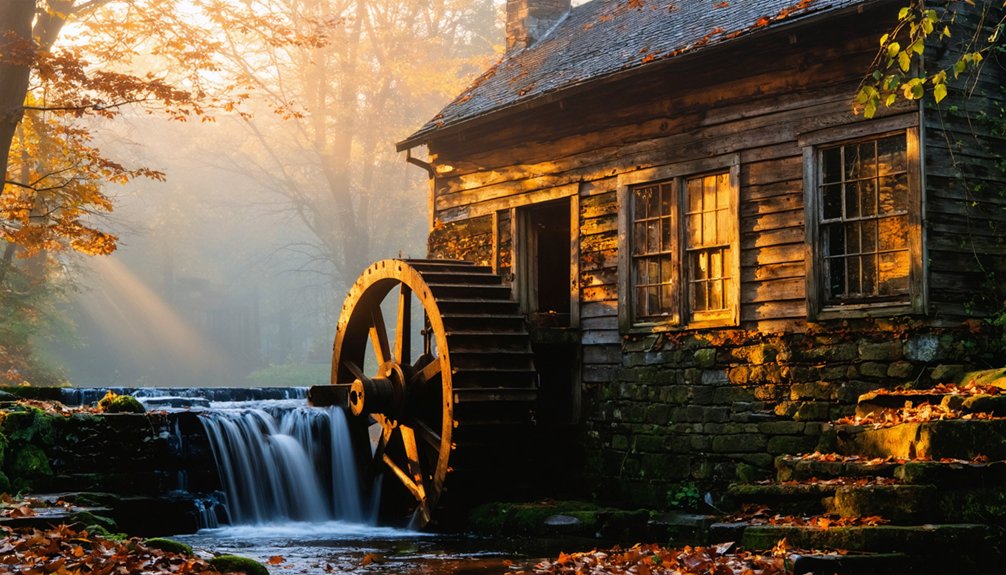
When you’re composing images of abandoned mills, the ethereal quality of golden hour bathes weathered timbers and rusted machinery in amber light that evokes the ghosts of industrial pasts.
Winter’s low-angled sun casts elongated shadows across mill yards and through vacant windows, revealing architectural details and spatial relationships obscured during other seasons. The blue hour after sunset provides an excellent opportunity to capture the haunting silhouettes of mill structures against the deepening sky, offering a dramatic contrast that emphasizes their historical significance.
Early morning mist rising from nearby waterways or settling in mountain valleys transforms ordinary mill ruins into otherworldly tableaux, where history seems suspended in the diffused, pearlescent light. For optimal portrait lighting conditions at these locations, schedule your photo sessions around 9 AM when shooting on the west side of mill structures, avoiding the harsh shadows of midday.
Golden Hour Magic
The ethereal quality of sunlight during the elusive golden hour transforms ordinary mill ruins into hauntingly beautiful reminders of America’s industrial past. As the sun hangs low on the horizon just after dawn or before sunset, it bathes these weathered structures in a warm, golden glow that accentuates every textural detail and architectural nuance.
You’ll discover that this fleeting light quality creates dramatic shadows and highlights that reveal the character etched into crumbling walls and rusted machinery.
Position yourself to capture the interplay between light and the unique silhouettes of these industrial ghosts. The directional illumination separates foreground elements from background, adding profound depth to your compositions. Visitors consistently give Mill Ruins Park exceptional ratings for its photographic potential. The transition into blue-hour light offers a spectacular backdrop for capturing the Minneapolis skyline reflected in the water.
For ideal results, scout locations beforehand using apps like PhotoPills, arriving early to establish your position as the golden light emerges to resurrect these silent monuments to America’s manufacturing heritage.
Winter Shadows Reveal
Winter’s crystalline light reveals the architectural anatomy of abandoned mills with unparalleled clarity, casting elongated shadows that transform ordinary structures into dramatic sculptural forms.
You’ll discover that winter’s lower sun angle creates shadow play across mill facades that remain hidden during other seasons, exposing structural elements previously obscured.
The reduced atmospheric moisture characteristic of cold mountain air increases light clarity, allowing you to document minute details with unprecedented precision.
Snow-covered grounds act as natural reflectors, brightening shadow areas and reducing harsh contrasts that typically challenge exposure settings.
When frost forms on weathered timber and rusted machinery, these crystalline patterns catch and diffuse available light, creating ethereal winter contrasts that tell the story of time’s passage through these abandoned industrial sentinels.
The historic Crystal Mill, built in 1892 above the Crystal River, offers particularly striking winter photography opportunities when its weathered wooden structure contrasts against pristine snowfall.
Researching specific location access is essential as many ghost towns require fees or reservations before you can photograph their historic structures.
Morning Mist Effects
Drifting like ghostly apparitions across abandoned millscapes, morning mist transforms ordinary ruins into ethereal tableaux that photographers have long sought to capture. September and October offer ideal conditions when radiation fog settles just before sunrise.
You’ll need to arrive before first light, when misty atmospheres linger longest near water bodies and wet fields common to these historical sites. The diffused glow creates ethereal landscapes particularly suited to longer focal lengths (70-200mm) that isolate and emphasize depth.
- Set daylight white balance to preserve cooler blue tones characteristic of dawn
- Use a tripod for stability during the inevitable longer exposures
- Consider manual focusing as autofocus often struggles in misty conditions
- Seek elevated viewpoints to capture layered mist revealing the mill’s skeletal remains
Your patience will be rewarded with haunting imagery that speaks to both memory and abandonment.
Architectural Elements That Tell Industrial Stories
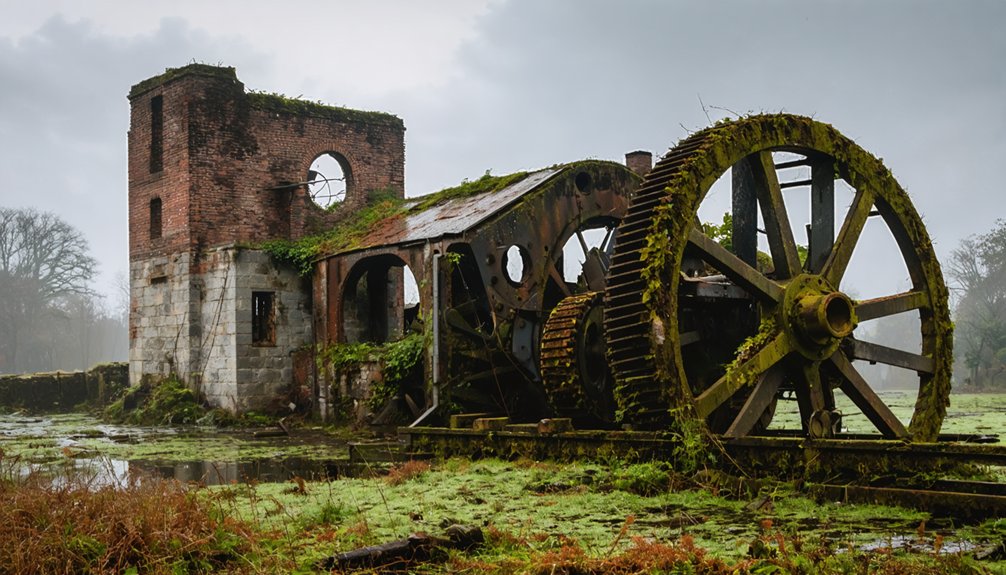
When you examine the multi-pane windows of abandoned mills, you’ll notice how their geometric patterns once funneled daylight onto factory floors where laborers toiled from dawn until dusk.
The exposed timber beams, with their distinctive weathering patterns and joinery techniques, reveal construction methods from an era when craftsmanship met industrial necessity.
Amid the stillness, you’ll find machinery foundations and partial mechanisms—iron behemoths now frozen in time—that silently narrate the technological processes that once powered these economic engines of rural America.
Windows of Time
The crumbling facades of abandoned mills stand as silent historians, their architectural elements whispering tales of America’s industrial past with eloquent precision.
As you explore these time capsules, you’ll discover that each structural component—from mortise and tenon joints to hand-hewn timber—reveals the craftsmanship that defined an era now lost to progress.
- Stone foundations, often several feet thick, remain defiant against time while upper structures have long surrendered.
- Millraces and waterwheel remnants chart the ingenious harnessing of natural power systems.
- Abandoned machinery rusts in dignified silence, preserving technological innovations of the 19th century.
- Faux bois techniques and salvaged historical pieces demonstrate how aesthetic concerns married industrial necessity.
These architectural elements transform your nostalgia exploration into an intimate communion with America’s industrial heritage, inviting deeper understanding of the engineering triumphs they represent.
Weathered Timber Patterns
Among the most eloquent storytellers in these abandoned industrial landscapes, weathered timber patterns speak with remarkable precision about America’s manufacturing past.
You’ll find mortise and tenon joints exposed by decades of weathering, revealing craftsmanship that defined 19th-century industrial architecture. The timber decay tells a layered narrative—oxidized surfaces darkened by tannins contrast with lighter areas where moss colonization has softened harsh textures.
Look closely at structural beams where vibration patterns from long-silenced machinery have left their signature impressions. Weathered textures reveal saw marks from primitive blades, while exposure checks follow growth rings like nature’s timeline.
The charred undersides of trestles and blackened corner posts remind you of the ever-present danger that stalked these once-bustling hubs of American industry.
Machinery Frozen Still
Massive iron gears, their teeth frozen mid-rotation, offer perhaps the most haunting evidence to industrial abandonment throughout America’s ghost mill towns.
You’ll find yourself transported through time as you witness the machinery nostalgia embodied in untouched control panels, rusted Singer sewing machines, and complex transmission systems that once powered multi-story operations.
The industrial silence speaks volumes—these mechanical marvels appear as if workers simply stepped away moments ago, leaving a perfectly preserved mechanical tableau.
- Square nails and mortise-and-tenon joinery reveal construction techniques predating modern standards
- Coolant reservoirs in mill floors demonstrate sophisticated fluid management systems
- Spindles draped with ivy preserve the spatial organization of textile manufacturing
- Rust patterns on metal frameworks document the passage of decades without human intervention
Capturing the Human Element in Abandoned Spaces
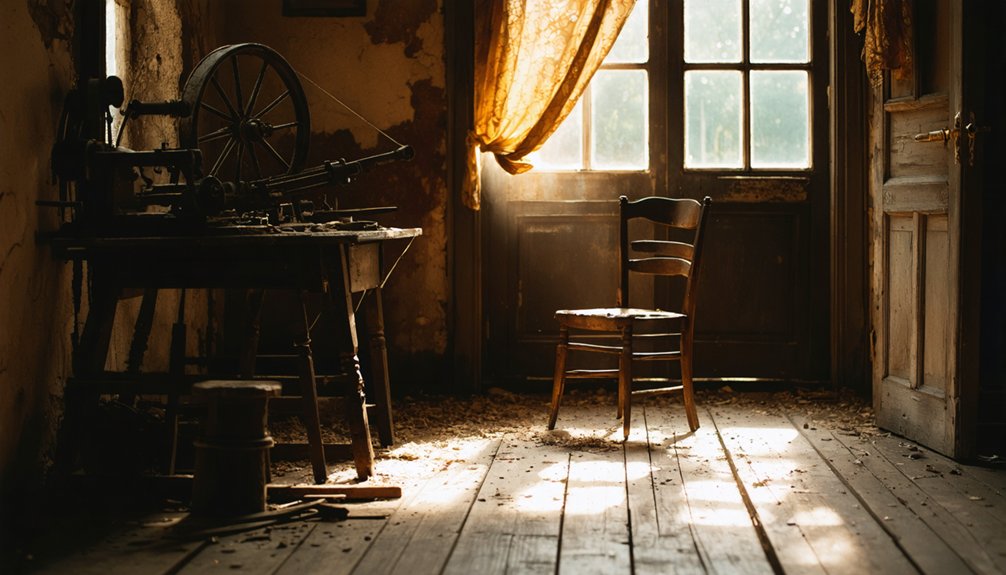
Wandering through abandoned mill towns, you’ll discover that ghostly structures are never truly empty; instead, they remain filled with poignant human echoes waiting to be noticed and documented. A teacup left mid-sip, a child’s boot beside a doorway, or faded family photographs create profound human connections to those who once called these spaces home.
As you photograph these intimate details, you’re crafting visual narratives that preserve transient memories. Focus your lens on handwritten notes scratched into walls or personal belongings arranged as if their owners might return any moment. These elements create emotional resonance far beyond crumbling architecture alone.
These historical reflections offer legacy reminders of communities that once thrived. Through your careful documentation, you’re not just capturing decay but honoring the dignity of lives once lived—stories that might otherwise disappear entirely.
Seasonal Considerations for Mill Town Photography
The shifting seasonal canvas dramatically transforms abandoned mill towns throughout the year, offering photographers distinct opportunities and challenges with each passing month.
Spring challenges include maneuvering through muddy terrain and unstable structures, yet melting snow creates compelling reflections against weathered mill facades.
Summer crowds necessitate early arrivals, while the season’s extended golden hours provide ideal lighting despite midday harshness.
Autumn colors reach their zenith between June and October, with golden aspens creating striking contrasts against industrial remnants.
Winter access becomes severely limited as snow accumulates, though those who brave the elements discover pristine landscapes and dramatic shadows from low-angle sunlight.
- Each season reveals a different historical narrative within these forgotten industrial monuments
- Consider how seasonal light interacts uniquely with deteriorating architectural elements
- Your equipment requirements will shift dramatically from summer’s heat to winter’s battery-draining cold
- Night photography opportunities remain consistent year-round, though seasonal backdrops transform the visual story
Ethical Practices and Preservation Awareness
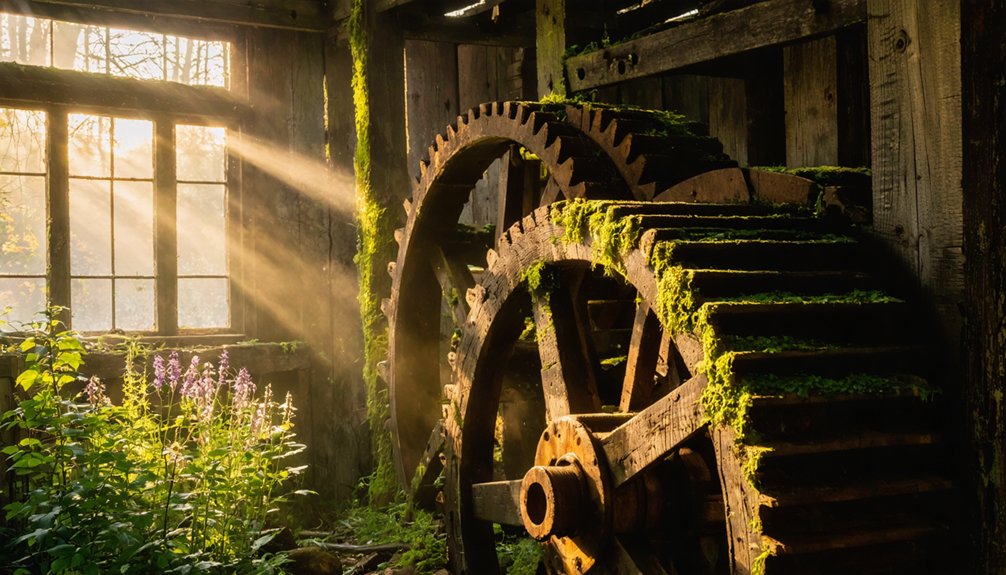
Beyond capturing the perfect image lies a profound responsibility to protect what remains of these industrial relics.
As you explore these fragile time capsules, practice ethical tourism by respecting property boundaries, staying on established paths, and never removing artifacts—each brick and rusted gear tells an irreplaceable story.
Your presence should leave no trace; pack out all waste and refrain from climbing deteriorating structures that have weathered decades of abandonment.
Tread gently through history’s remnants—leave only footprints, preserve only memories, disturb nothing but silence.
Consider supporting preservation initiatives by documenting sites through photography rather than physical disturbance, and sharing your knowledge with historical societies dedicated to safeguarding these vanishing landscapes.
Post-Processing Techniques to Enhance Ghost Town Imagery
Once you’ve captured the haunting beauty of abandoned mills in your camera, skilled post-processing becomes essential to truly convey their atmospheric presence and historical weight.
Programs like Adobe Lightroom offer nuanced contrast adjustments to emphasize decay and texture, while Photoshop enables advanced compositing for ethereal effects. Many photographers employ monochrome treatments to accentuate the timeless quality inherent in these forgotten industrial monuments.
- Apply careful shadow recovery to reveal interior details while maintaining the mysterious ambiance
- Experiment with selective desaturation for an authentically aged appearance
- Consider light painting effects blended in layers for ghostly illumination
- Add subtle grain or film-like textures to evoke historical documentation
For particularly dramatic scenes, balance highlight reduction with midtone enhancement to preserve atmospheric haze while ensuring architectural elements remain visually prominent.
Frequently Asked Questions
Are Permits Required to Photograph in Protected Mill Ghost Towns?
You’ll absolutely need permits for professional photography in protected mill ghost towns. Photography regulations guarantee historical preservation while you capture timeworn splendor. Personal snapshots generally don’t require permits, but commercial work demands proper documentation.
How Dangerous Are Deteriorating Mill Structures for Photographers?
Extremely dangerous. You’ll face life-threatening challenges from compromised structural integrity—rotting beams may collapse without warning. Always prioritize safety precautions; wear protective gear and never explore these decaying industrial cathedrals alone.
Can I Sell Photographs Taken in Historical Mill Sites?
Over 65% of historical photographs generate considerable revenue. You can sell your mill site images if taken from public property, avoiding copyright issues while exercising your photography rights on these hauntingly evocative vestiges of industrial antiquity.
Which Ghost Towns Allow Drone Photography of Mill Complexes?
You’ll find drone photography opportunities at Lamar County’s Chappell Mill with owner permission, and in California ghost towns near national forests, where drone regulations allow flights below 400 feet. Research local photography tips beforehand.
Are Overnight Stays Permitted in Any Mill Ghost Towns?
Like portals to the past, you’ll find ghost town accommodations at Calico, Pioneertown, St. Elmo, and Goldfield. Historical site regulations permit overnight stays through official lodging, camping, or private arrangements with owners.
References
- https://stateofwatourism.com/ghost-towns-of-washington-state/
- https://pamphotography.blog/2023/07/08/how-to-photograph-ghost-towns/
- https://www.orphanednation.com/the-ghost-town-of-henry-river-mill-village/
- https://m.dresshead.com/files/scholarship/Documents/Ghost_Towns_Lost_Cities_Of_The_Old_West_Shire_Usa.pdf
- https://www.visitouray.com/ghost-towns
- https://www.youtube.com/watch?v=Ev2OZy3bNAc
- https://albiongould.com/ghost-towns-to-visit-in-the-states/
- https://www.youtube.com/watch?v=kdE5O-cI1Bo
- https://www.christywanders.com/2024/08/top-ghost-towns-for-history-buffs.html
- https://en.wikipedia.org/wiki/Ghost_town
